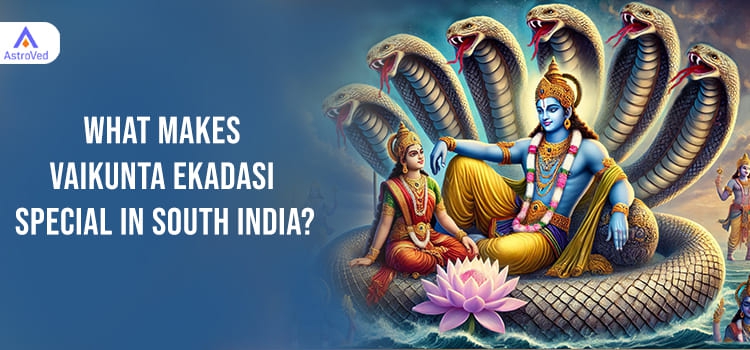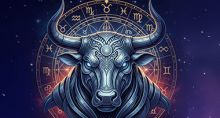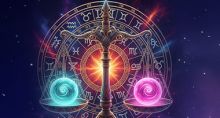What Makes Vaikunta Ekadasi Special in South India?
Vaikuntha Ekadashi, also called Mokshada and Mukkoti Ekadashi, is an important Hindu festival that honors Lord Vishnu. It is especially important for Vaishnavites or devotees of Vishnu. It is a very auspicious day, and people in South India celebrate it with great devotion and enthusiasm. Its religious and spiritual significance is immense. People offer prayers, observe a fast, and make visits to Vishnu temples on this day. Spiritual fervor fills the temple town of Srirangam as large numbers of devotees congregate at the renowned Sri Ranganathaswamy Temple to celebrate Vaikunta Ekadasi. It falls in the Tamil month of Marghazhi (Dec-Jan). There are many unique rituals in Vishnu temples on this day, including the opening of the Vaikuntha Dwaram or Paramapada Vasal.
Vaikuntha is Vishnu’s heavenly abode, while ‘Dwaram’ means ‘gateway’ or ‘entrance’. According to Hindu mythology, the door to Vaikuntha opens on this day. Devotees who observe a fast with true devotion and offer prayers to Vishnu can attain Moksha or freedom from the birth-death cycle and enter his celestial abode on this day. Devotees pass through a special entrance in Vishnu temples, symbolizing their entrance into Vaikuntha.

Vaikuntha Ekadashi Celebrations in South India
In Tamil Nadu, the celebration hinges around the opening of the Parampada Vasal. This is supposedly the seventh gate that represents the gateway to heaven in temples. The festival also fosters cultural richness and unity in the community. It is not just a religious event. On the other hand, it is also a cultural event that brings people together. Vaikuntha Ekadashi is celebrated grandly at Tirumala Tirupati temple in Andhra Pradesh. Devotees from all parts of South India flock to these temples to take part in the festivities and offer worship.
Significance of Vaikuntha Ekadasi
There are two Ekadasis in a month and 24 in a year. Vaikunta Ekadasi, which falls in the Shukla paksha in Margazhi, is the most important of these.
One day in heaven equals a full Earth year. Margazhi is the month immediately before the Uttarayana period, the beginning of the Sun’s northern journey. It represents the hour before daybreak in heaven, and the moment Vishnu opens his eyes. The significance of Ekadasi in Margazhi is revealed in Krishna’s words to Arjuna, ‘Masanam Margaseershoaham’ in the Bhagavad Gita. The phrase means ‘among the months, I am Margazhi.’
For most Hindus, attaining Moksha is the ultimate goal. The belief is that when one attains Moksha, one is liberated from the cycle of birth and death. Only by attaining Moksha can one gain a place in heaven. Vaikunta Ekadasi is seen as important due to its association with attaining Moksha.
Legend behind Vaikuntha Ekadashi
The Padma Purana mentions how Vaikunta Ekadasi came to be celebrated. Once, a demon Muran received boons from Vishnu and began to trouble everyone. Finally, Vishnu confronted him and they engaged in combat. They fought for many years. At one point, Vishnu felt exhausted and took rest in a cave. Muran entered the cave and tried to kill the sleeping Vishnu.
However, a female form emerged from Vishnu’s chest and killed Muran. This incident happened on the 11th day of Margazhi Shukla Paksha. A pleased Vishnu named her Ekadasi and told her to ask him for a boon. She sought Moksha for Muran and all those who prayed to Vishnu on this day.
Vishnu also granted a similar boon to the demons Madhu and Kaithaba, who were born from his ear wax. The demons stole the Vedas from Lord Brahma and Vishnu killed them. Vishnu opened the north gate or Vaikunta vaasal for them. This act is replicated in Vaishnavite temples through the practice of opening the Sorga Vaasal on Vaikuntha Ekadasi.
Vaikuntha Ekadasi Rituals
On the day of Vaikunta Ekadasi, devotees observe vrat/fast, worship Vishnu, and keep vigil during the night. They also sing nama sankirtan and play Paramapadam, or the game of snakes and ladders. The snake signifies the ego that pulls us down, while the ladder represents a pure heart that will help us attain Moksha and ascend to heaven.
Vaikunta Ekadasi Celebrations at Sri Ranganathaswamy Temple
Sri Ranganathaswamy Temple is one of the 108 Divya Kshetrams of Vaishnavism. It is often described as ‘Booloka Vaikuntham’ or Vaikuntham on earth. During Vaikunta Ekadasi, the temple door is opened on the southern side. The main deity, Ranganatha, emerges from it to bless devotees who chant ‘ranga ranga.’ The belief is that those who witness the deity at the southern entrance will gain Moksha or a place in Vaikuntam at the feet of Vishnu.
The most important event on Vaikuntha Ekadasi is the Vaikuntha Dwara Darshanam. This refers to the passage leading to the innermost sanctum of the temple. Devotees queue up to pass through this gateway.
Vaishnavites observe a fast on this day and break it on Mukkoti Dwadashi day or the day after Mukkoti Ekadashi. They avoid all rice-based foods on this day, as Muran is believed to dwell in the rice that people eat on Ekadasi day. Some devotees also meditate, do Japa, and sing Hari Kirtan.













